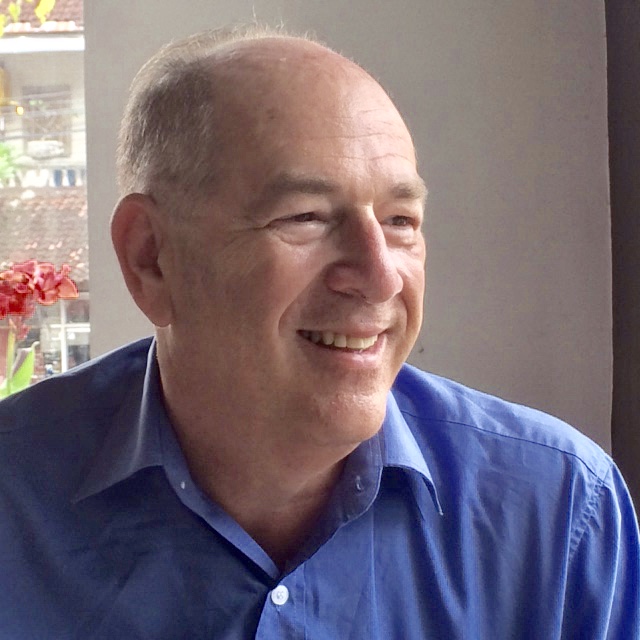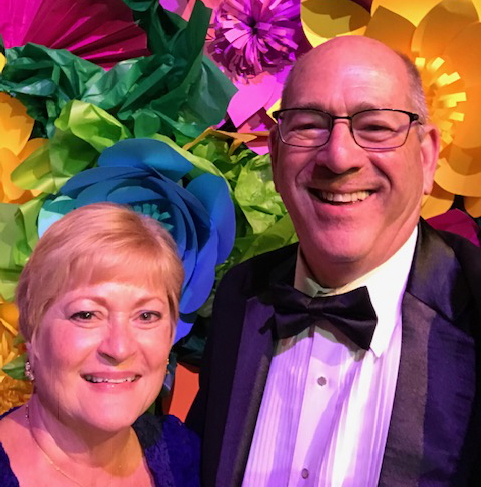Article: Tom Youkilis Remembers First Small Steps of JDRF Walkathon
Perhaps as if to prove the old adage that “A journey of 1,000 miles begins with a single step,” Tom Youkilis remembers the very humble beginnings of what is now one of Greater Cincinnati’s most popular and successful charity walkathons.
Youkilis, 64, is in the Starbucks on Route 747, in an outlot at Tri-County Mall a couple of miles north of his Glendale home, as he recalls the story.
The year was 1983. Youkilis was 29 and already a type 1 diabetes “veteran.” He was diagnosed at age 13, and after finishing college at the University of Cincinnati, became involved with the Juvenile Diabetes Foundation (now JDRF). He served as chairman of the annual bike-a-thon, which was really several events all taking place at the same time.
“Back in those days it was a very small-time operation. A small group of dedicated volunteers. The founder of the chapter was still heavily involved. We worked out of a horrible little office in St. Bernard. It was just a disaster,” Youkilis said. “But again, everything was all volunteer. Everything done by volunteers, and it was just a committed group of people. Back in those days, the biggest fundraiser for our chapter was our JDRF bike-a-thon, and the bike-a-thon … by today’s standards would be totally unmanageable. It was 10 different locations all around the Greater Cincinnati area.”
The bikeathon usually took place in the spring – May, specifically. Riders, the majority of whom were kids, would secure pledges, ride in the event, collect pledges and turn in the money. Participants rode on city streets in neighborhoods such as Deer Park, Montgomery and Norwood, as well as the bike trail at Cincinnati’s Lunken Airport.

“Somehow it all worked, we managed to get all of our money, and it worked great, but there was no national tie-in to anything, so we had to get local sponsorships, one of the fast food chains always did something, one of the pharmacies would do something, we always had something to give away to people, but it was just an amazing feat, it was just amazing that we could pull it off that many years, and again it was all because of these volunteers,” Youkilis said.
For its time, the bikeathon was an unquestioned success, regularly raising more than $100,000 a year.
JDRF’s national office suggested a walkathon as a fundraiser – an idea about which the Cincinnati group was receptive if not overly enthusiastic.
“I was president at the time, and we had this bike-a-thon going and we couldn’t ask too much more of our volunteers, so we said ‘Let’s just give it a shot. We weren’t going to commit a lot of time or energy to it,” Youkilis said. “So one way to avoid the weather issue was we decided to do it at the mall. So it actually was at Tri-County Mall. We decided to do our first walk-a-thon. The mall management was pretty OK with it. We had to do it early, I think, was the rule… so the bottom line to the story is I think we had about two walkers show up. We didn’t publicize it well, we didn’t do much of anything with it. There was some word out where people heard about it, said ‘I’ll try it,’ so we had about two people show up. Probably didn’t raise $100 that year, but at least we got our foot in the door and got us started.”
Eventually the walkathon grew to the point that the chapter dropped the bike event – “Too many issues, and we always had safety concerns and we were always worried someone as going to get hurt,” Youkilis said.
The most recent walk, now branded as the JDRF One Walk, was June 2 at Kings Island, drawing more than 8,000 participants and raising more than $940,000. This year, JDRF combined three walks into one, phasing out past events in Dayton and Northern Kentucky.
Youkilis, who still volunteers at the event, credits the location as one of the main reasons for the walk’s success. The first Kings Island walk took place in 1994.
“It has turned into a big, big deal, obviously, and getting Kings Island involved, that was wonderful. It has turned into a great draw, because anyone can do a walk, but we had that attraction,” he said. The walk course begins in the parking lot and goes through the park during the early morning hours. Participants and volunteers are eligible to receive same-day passes to the park.
There is a touch of irony associated with having the walk at the amusement park, as Youkilis explained, and it illustrates the changes in the type 1 landscape since he was diagnosed in 1967.
“Fifty-one years ago, No. 1 people didn’t talk about it, so I never told people I had diabetes. I always like to tell the story back then, Kings Island had just opened up, and if you wanted a diet soft drink at Kings Island, there were only like two stations in the whole park that served diet, so you had to go to those places to get it, so that was awkward,” he said.
He also talked about how his doctor at the time suggested he always wear white socks so that any foot infections would be readily apparent.
“So here I am, newly diagnosed, they’re telling me to wear white socks, I thought there’s no way I could do that, so I didn’t do that. In those days, we didn’t have disposable syringes, so in my dresser I had a jar filled with alcohol, and that’s what you put the syringe in. We did have disposable needles, so you would put that on, the disposable needle on it. That was a challenge.”
Youkilis marvels at the advances in technology is the ensuing half-century, as well as the change in thinking and treatment. He remembers that when he was first diagnosed, he gave himself one injection per day, in the morning, to cover his needs for the next 24 hours. That required a daily urine test for blood sugar, and a call to his physician every morning, always aware and afraid that he was waking up the doctor.
“In those days, if you missed a meal, you were in trouble. That was a little awkward. So I always had to carry something with me – sugar tablets or whatever we had, so that got to be a problem sometimes, but I never really had any serious instances, but you really were more aware, and of course back then, everything was done on urine testing, and today in hindsight, you think ‘What was that about?’” he said.
‘Your urine sugar would be really high, but that was five hours ago, so where you are this second means absolutely nothing. I think back to my high school days and on a weekend, we’d go out, a bunch of us guys, and we’d eat a pizza at midnight, and I’m thinking, ‘I can’t imagine what really was going on with my blood sugar back then, because today if I eat pizza, I know about it, but we didn’t even think about it. That was one of the biggest problems was just not knowing where you stood, so that was a little awkward.”
Perhaps because of those experiences, Youkilis has not fully immersed himself in the available technology. He wears a continuous glucose monitor, but not an insulin pump. This day, he carried his pen in his shirt pocket, and injects himself with insulin as needed.
“So part of my rationale here is I’ve had the disease long enough, that I take so many shots – I’ve been taking shots all of my life – I have plenty of fat, to take a shot once, twice, four times a day means nothing to me, so while people on the pump might say, ‘Oh, my blood sugar’s going up, I need to adjust something,’ and hit a button, I just take a shot. I carry my pen with me all the time, it’s not an issue,” he said.
“Now, what I have talked to my doctor about … she did say within a year or so the whole closed loop system is going to be so much simpler and easier, and I might look at it at that point, but for now, my CGM I absolutely love.”
JDRF Southwest Ohio Executive Director Melissa Newman said Youkilis’s influence has been felt in all aspects of the organization.
“Tom has been a longstanding volunteer for JDRF, and his continued commitment after all this time is truly impressive. As a member of the Board of Chancellors, Tom joins fellow past board presidents in helping provide valuable insight and chapter history to me, which helps direct the chapter,” Newman said. “Over Tom’s decades of involvement, he’s been part of almost every program and event our chapter holds, and we are very appreciative of his support.”
When he was president, Youkilis said, he would call parents of newly diagnosed type 1 diabetics with a simple message of encouragement.
“Someone did this for my mother, and say ‘This is not the end of the world. You will live with this disease. It is not horrible. No matter what you heard, you know, your great aunt or your grandma had diabetes, but I think just people need to be reassured that it’s really OK, it’s not the end of the world, and today with all of the technology and everything else, it really is manageable.’”
Youkilis has stepped back from day-to-day involvement with JDRF. A retired Procter & Gamble purchasing manager, he works part time from home, and he and his wife, Alison, spend winters in Southeast Asia, usually Thailand, which can present its own challenges.
“The biggest question, and again some people would probably really freak out about this, is all of the time changes. So when we fly to Thailand, you lose a day, so it’s literally 24 hours to get there, so … that’s where the monitor really helps. So I kind of just start fresh whenever I get there. I say, ‘OK, it’s morning here, it’s morning for shots,’ but if I’m watching my blood sugar, if my long-term Lantus is wearing off, I’ll just take more of my Humalog and just kind of stay on top of it until we get there, and then just kind of go for it. To try to calculate and monitor, it’s easier to pretend it didn’t happen.”
Whether in his Glendale home or halfway across the globe, Youkilis’s influence is felt by type 1 diabetics and their families every day.
“When I look at what we have done in terms of research, funding research, and how that’s gotten down to the actual users, it is phenomenal. We wouldn’t have had the monitors, the pumps, any of the treatments, the eye treatments, all of the complication issues, so someday we might get to that cure stage, that preventive stage, but to those of us who are still around, they’ve made life just incredibly better and we couldn’t have done it without all this money, and that’s really what it takes.”
Written by: Richard Maloney, JDRF Volunteer